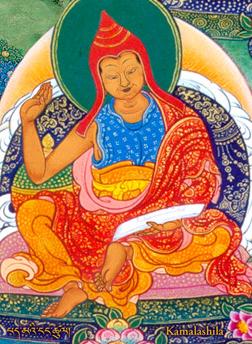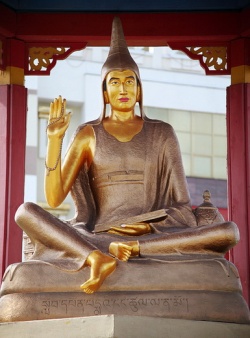Kamalashila
Kamalashila (Skt. Kamalaśīla; Tib. པདྨའི་ངང་ཚུལ་, Pemé Ngang Tsul; Wyl. pad+ma'i ngang tshul) (c. 740-795) — this master was the main disciple of the great abbot Shantarakshita.
Kamalashila (740–795)
The great Indian scholar from Nalanda Monastery who accompanied Shantarakshita to Tibet to try to revitalize Buddhism there. He is noted for his three texts called Stages of Meditation (Skt: Bhavanakrama).
He famously defeated a Chinese master of the Hashang school (whose personal name is sometimes given as Mahayana Hashang) in the great debate at Samyé, which took place around 792 AD, thereby ensuring that the Tibetans followed the Indian tradition of Madhyamika which had flourished at the great Nalanda Monastery. He died in Tibet in around 795.[1]
Principal Writings
His most famous compositions are the three texts entitled Stages of Meditation (Skt. Bhāvanākrama), on which H.H. the Dalai Lama has taught several times.
 སྒོམ་རིམ་, The five bhavanakrama of Kamalasila and Vimalamitra: a collection of texts on the nature and practice of buddhist contemplative realisation
སྒོམ་རིམ་, The five bhavanakrama of Kamalasila and Vimalamitra: a collection of texts on the nature and practice of buddhist contemplative realisation
His other works include:
- Commentary on the Difficult Points of the Compendium of Reality (Tattvasaṃgraha-pañjikā)
- Commentary on the Difficult Points of the Ornament of the Middle Way (Skt. Madhyamakālaṅkārapañjikā; Tib. དབུ་མའི་རྒྱན་གྱི་དཀའ་འགྲེལ་, Wyl. dbu ma'i rgyan gyi dka' 'grel)
- Light of the Middle Way (Skt. Madhyamakāloka; Tib. དབུ་མ་གསང་བ་, Wyl. dbu ma snang ba)
Footnotes
- ↑ Seyfort Ruegg, Literature, p. 94
Further Reading
- Khenchen Thrangu Rinpoche, Essential Practice, translated by Jules B. Levinson (Ithaca: Snow Lion, 2002)
- David Seyfort Ruegg, The Literature of the Madhyamaka School of Philosophy in India (Wiesbaden: Harrassowitz, 1981), pages 93-99
Source
Kamalaśīla (fl. 713-763) was an Indian Buddhist of Nalanda Mahavihara who accompanied Śāntarakṣita (725–788) to Tibet at the request of Trhisongdetsen.
Dargyay, et al. (1977, 1998: p. 7) convey a lineage of transmission and translation of Śīla, Sutrayana Buddhavacana and the Six Pāramitā's (viewed principally through the Mahayana teachings of Nāgārjuna), from India to Tibet (paṇḍit in this context denotes a Sanskrit scholar):
The Indian pandits, represented mainly by Śāntarakṣita, Kamalaśīla, and his disciple Ye-śes-dbang-po, form a known group. These scholars were all defenders of the Madhyamaka school, which is based upon Nāgārjuna's teachings. First of all, however, they taught the ten rules of behaviour of the Buddhist ethics (śīla) and a summary of the teachings according to the canonic Sūtras of the Mahāyāna, as well as the virtuous works of the six pāramitās. These exercises are supposed to lead, in a long seemingly endless way, to the gradual ascent to the acquisition of higher intellectual abilities finally culminating in Buddhahood. This trend was intensified after the debate of bSam-yas had taken place in the years 792 to 794; the exact outcome of this debate is still debatable.
Debate of Samye / Lhasa
Works
Trilogy of Stages of Meditation (bhāvanākrama)
Kamalaśīla is renowned for writing three texts, all called Bhāvanākrama (Stages of Meditation), which summarize and build upon aspects of the Yogācāra tradition of Asanga, particularly as pertaining to aspects of meditation practice. The first text has been translated into Classic Chinese.
Commentary on Madhyamālaṃkāra
(Sanskrit: Madhyamālaṃkāra-panjika, Wylie: dbu ma rgyan gyi dka' 'grel)
Commentary on Difficult Points (Sanskrit: Madhyamālaṃkāra-panjika, Wylie: dbu ma rgyan gyi dka' 'grel) by Kamalaśīla
Illumination of the Middle
Illumination of the Middle (Skt. madhyamakālaṃkāra, Wylie: dbu ma snang ba) by Kamalaśīla
Teaching story
There is a morality tale, allegory and teaching story inherent within the transmission of Chöd to Tibet that has been culturally remembered as a Cham Dance. In this sacred dance, Moheyan is generally depicted as of ample girth, goaded by children. Chöd is a product of both the Indian and Chinese transmissions of Buddhism into the Himalaya. For a discussion of the Dunhuang fulcrum of the entwined relationship of Chinese and Indian Buddhism see van Schaik and Dalton (2004).
For simplicity, the Indian tantric transmission may be characterized as "gradual" (Tibetan: rim gyis ‘jug pa; Chinese: tun-wu) and the Chinese Ch'an transmission may be characterized as "direct" (Tibetan: cig car gyi ‘jug pa; Chinese: chien-wu). It needs to be emphasized that this neat dichotomy in characterization of these two approaches to the Dharma, is only valid for the historical context of the great debate between Kamalaśīla and Moheyan, arranged by Trisong Detsen and even then it is still open to dialectic.
This debate has been named the "Council of Samye" by Giuseppe Tucci but is generally known as the "Lhasa". According to the general Tibetan tradition, the two years of the debate transpired at Samye, a significant distance from Lhasa. According to the lore of the orthodox, prevailing Tibetan cultural tradition, Kamalaśīla, a mahapandita and scholar educated at Nalanda, advocated the "gradual" process to enlightenment; whereas, Moheyan, as a trance and meditation master, advocated the "direct" awakening of original mind through the nirodha (Sanskrit) of discursive thought, the cessation of the mind of ideation.
The historicity of this debate has been drawn into question by Tucci & Heissig (1970),Gomez (1983) and Ruegg (1992) though this does not lessen its importance in defining the religious and cultural traditions of Tibet. Kamalaśīla was very handsome and a great orator and historically "won" the debate: though there are conflicting primary sources and secondary accounts.
One hagiography asserts that directly after this debate with Moheyan, as Kamalaśīla was making his way down from the Himalaya to the Indian lowlands, he was incited to enact phowa through compassionate duress, transferring his mindstream to animate a corpse polluted with contagion; and thereby, safely moving the hazard it presented to a nearby community. As the mindstream of Kamalaśīla was otherwise engaged, a Mahasidda by the name of Padampa Sangye came across the vacant kuten or "physical basis" of Kamalaśīla.
Padampa Sangye, was not karmically blessed with an aesthetic corporeal form, and upon finding the very handsome and healthy empty body of Kamalaśīla, which he perceived as a newly dead fresh corpse, transferred his mindstream into Kamalaśīla's body. Padampa Sangye's mindstream in Kamalaśīla's body continued the ascent to the Himalaya and thereby transmitted the Chöd. The mindstream of Kamalaśīla upon endeavouring to return to his kuten was unable to do so and resorted by necessity to the vacant body of Padampa Sangye. The mindstream of Padampa Sangye continued in this body, and it is in this handsome body that the transmission of Chöd was made to Machig Labdrön, his consort.

